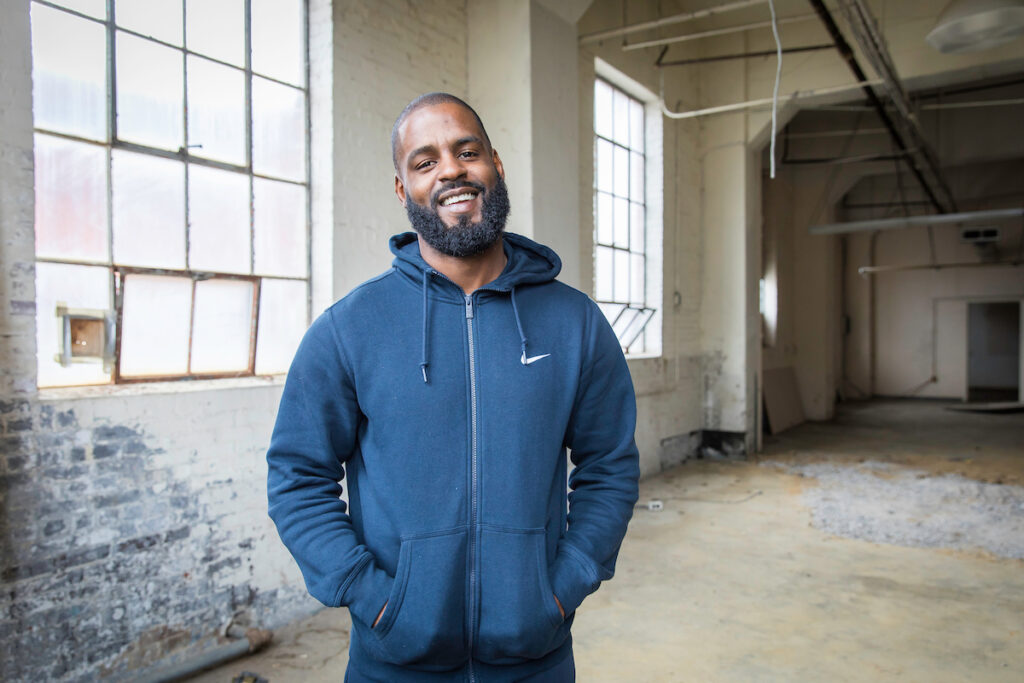By Maggie Heyn Richardson
Anthony Kimble of Kimble Properties is investing in the rise of Mid City.
Anthony Kimble of Kimble Properties is investing in the rise of Mid City.
Every so often, business owner David Applegate steps out onto the balcony of his building at 14th and Government Streets to look at the world below. Thousands of cars speed by daily, trekking into downtown from parts east, and back again at the end of the work day. Trains rumble down the Kansas City Southern railroad line that runs alongside the property.
Neighborhood residents, many of whom Applegate knows by name, pass through the area on foot. And these days, construction trucks plied with fresh materials head for dormant structures nearby whose transformation is underway.
This corridor, which once pulsed as Baton Rouge’s warehouse district, has been buzzing with action lately, as investors who see its untapped potential and advantageous location are starting to pull the trigger on new projects. Sandwiched between downtown and Mid City, 14th Street and its environs are fast becoming an urban lab where the promise of new businesses and housing could build community and opportunity among the area’s diverse residents.
Applegate, a longtime neighborhood property owner, operates a marine and industrial materials business at 1440 Government, an expansive space that once served as a railroad hotel. He says he’ll soon sell the building as he downsizes and moves his business to another location down the street.
“I probably won’t recognize the area in a few years,” he says.
The biggest project underway is the $20 million transformation of the former Entergy substation across the street led by architect Dyke Nelson and developer David Weinstein. Named the Electric Depot, the mixed-use development’s first phase includes 16 one-bedroom apartments, an entertainment venue called Red Stick Social, which features a bowling alley, live music stage and bar, a yoga studio and a healthy foods restaurant.
A portion of the apartments will be set aside as work-force housing, affordable options for working people with restricted incomes.
“The first phase will be completed by the end of 2018,” says Nelson. “You’ll be able to celebrate New Year’s Eve there.”
Entergy donated the six-acre complex to the East Baton Rouge Parish Redevelopment Authority in 2013 after it sat dormant for years. Little was noticeable about the vast site, save broken windows and barbed wire. The project is widely seen as an innovative approach to urban blight. It’s also viewed as a catalyst for the area, says Anthony Kimble, an investor on the project and neighborhood property owner.
“We realized that if anything was going to start moving this neighborhood forward it was this,” says Kimble. “It’s one of the biggest parcels of land around, and it definitely needed to happen first to show the neighborhood’s potential and attract interest. Nothing like this has really been done in Baton Rouge.”
The second phase of the project includes 120 more apartments, outdoor plaza space and plenty of parking, Nelson says.
Nelson says the objective of the project has been to maintain the architectural integrity of the building and the character of the neighborhood. The opportunity to rent in the area will appeal to existing area residents as well as those eager to live in downtown and Mid City, which both lack large residential developments.
Nelson has long appreciated the neighborhood’s potential. In 2012, he moved his architectural firm, DNA Workshop, to a 1919 building once used for wine bottling. It’s part of a strip of buildings and warehouses that run along 14th Street between Government Street and North Boulevard.
“I just really liked the texture of the area,” says Nelson. “And with so much already going on in downtown and Mid City, it was a place full of opportunity that really hadn’t been discovered.”
Nelson, along with partners Weinstein and DNA Workshop architect Abe Kinney are also transforming a 30,000-square foot warehouse across the street into a new commercial-retail space. Tenants include a commissary kitchen for a local restaurant group, a keg storage facility, a graphic design firm and event space with exposed beams and an edgy, warehouse feel.
“It’s not typical of what you see in Baton Rouge for events,” says Nelson. “With a building with this kind of character, the only thing you really have to do to is not screw it up.”
Elsewhere in the neighborhood, other changes are afoot. In 2017, French Truck Coffee was one of several new businesses to open on Government Street in Mid City in the former Southern Camera building. Developer Matthew Shirley, a Baton Rouge native, also intends to purchase the building next door once occupied by Avos Food Mart.
“Given the trajectory of the area, it made sense to buy here,” says Shirley, a commercial real estate broker with Saurage Rotenberg. “I’m a local guy, and it’s been great to see the changes along Government Street.”
In September 2017, the historic Lincoln Hotel at Government Street and Eddie Robinson sold to Solomon Carter, who has hinted at plans to transform it into a boutique hotel – the first of its kind in the area.
“The stars are finally starting to align for the area,” says Kimble, who owns a warehouse across the street from the hotel.
Changes to make Government Street more pedestrian friendly are also underway this year. The new road diet converts the four-lane thoroughfare to three lanes with a dedicated turn lane in the center and new space captured on the peripheries for pedestrian and bike lanes.
Nelson says the road diet is badly needed to make Government Street safer for all who use it.
“I hear people say, ‘why do we want to do this? No one walks in Baton Rouge,’ says Nelson. “I see people walking all the time in the neighborhood.”

